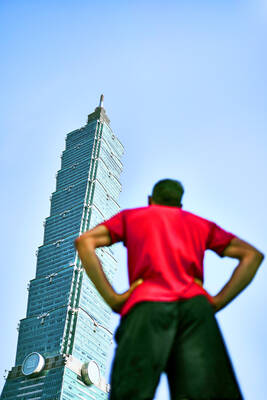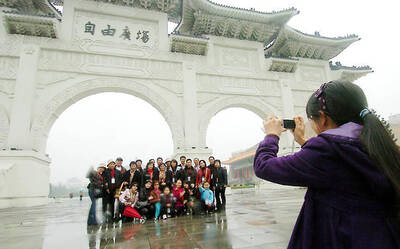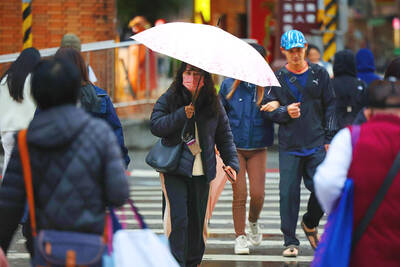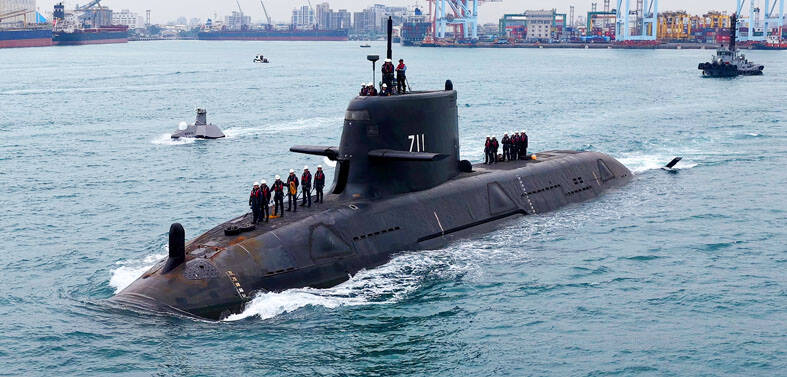Media outlets on both sides of the Taiwan Strait should enhance exchanges and cooperation in an effort to reduce differences, the head of a Chinese media delegation said upon concluding an eight-day visit to Taiwan.
Zhou Xisheng (周錫生), the head of the delegation and vice president of Xinhua news agency, told a farewell dinner on Thursday that the eight-day “exchange tour” was an effort to encourage “frank communication” and in-depth exchanges on the media and the impact of social media on traditional mass communication.
Only by strengthening cross-strait media exchanges can differences be reduced and avoided, the friendship deepened and cooperation expanded, Zhou said, adding that he welcomed colleagues in Taiwanese media to visit China more often and engage in more direct communication and cooperation.
“Whether in the streets all over Taiwan, or a visit to the National Palace Museum … reading newspapers or watching TV, we can deeply feel that the feelings of compatriots on both sides are thicker than water, and feel the Chinese nation’s long and splendid culture,” he said.
Zhou said Taiwanese media had “outstanding qualities” in operation, competition and professionalism, which had left a strong impression on him and his delegates.
The delegation included about 20 representatives from 10 major media organizations in China, including Xinhua, the People’s Daily, the Economic Daily News, China National Radio, China Radio International and China Central Television. State Council Information Office Deputy Director Wang Guoqing (王國慶) and Central Committee Propaganda Department Information Bureau Deputy Secretary Zhang Ye (張燁) also joined the group.
In a speech, Wang emphasized the importance of cross-strait exchanges and said media exchanges should be objective, impartial, comprehensive and accurate to ensure that people on both sides could deepen mutual understanding.
The delegation held meetings with or visited the offices of the Want Want Group, the China Times Group, the United Daily News, China Daily News, the Central News Agency, CTS, TTV and TVBS, among others.
The delegation also visited radio stations in Greater Tainan and Greater Taichung, as well as the Chinese Press Institute.
The visit, the third by a Chinese media delegation, was made at the invitation of the China Times.
The first one was held in March 2009.
The visit occurred amid reports that the top leadership in Beijing is considering “cultural reforms” that analysts say could be aimed at increasing official control over the media and the Internet to shape public opinion.
A meeting chaired by Chinese President Hu Jintao (胡錦濤) last week called for the “mastering of new trends in cultural development” and an emphasis on “Chinese characteristics” as part of the proposed overhaul, Xinhua reported.
According to the Agence France-Presse (AFP), analysts said the measures would likely tighten Beijing’s grip on newspapers, TV and popular social networking sites.
“All cultural controls have the essential political mission to shape the people’s mind to not directly challenge the party rule, to accept the status quo,” Xiao Qiang (蕭強), an adjunct professor at the school of journalism at University of California at Berkeley, told AFP.
“It highlights their nervousness and their awareness of the increasing challenges to their ability to control the cultural sphere,” said Xiao, who is also the founder and editor in chief of China Digital Times.
The tightening of controls follows a decade during which Beijing encouraged state-owned media to be more competitive and less reliant on state subsidies. As media competed for viewers, previously obedient stations and publications became more critical of the authorities or engaged in “racier” programming.
The Chinese Communist Party has seen this development as undermining its efforts to control public opinion.
There is “this anxiety over the influence of these truly commercially operating media, which have gained a lot of strength in the past decade and have huge audiences,” David Bandurski of the China Media Project at the University of Hong Kong told AFP.
“You really have seen the progressive loss of control by the official media and in recent years they have been trying to re-grab that agenda,” he said.

US climber Alex Honnold is to attempt to scale Taipei 101 without a rope and harness in a live Netflix special on Jan. 24, the streaming platform announced on Wednesday. Accounting for the time difference, the two-hour broadcast of Honnold’s climb, called Skyscraper Live, is to air on Jan. 23 in the US, Netflix said in a statement. Honnold, 40, was the first person ever to free solo climb the 900m El Capitan rock formation in Yosemite National Park — a feat that was recorded and later made into the 2018 documentary film Free Solo. Netflix previewed Skyscraper Live in October, after videos

NUMBERS IMBALANCE: More than 4 million Taiwanese have visited China this year, while only about half a million Chinese have visited here Beijing has yet to respond to Taiwan’s requests for negotiation over matters related to the recovery of cross-strait tourism, the Tourism Administration said yesterday. Taiwan’s tourism authority issued the statement after Chinese-language daily the China Times reported yesterday that the government’s policy of banning group tours to China does not stop Taiwanese from visiting the country. As of October, more than 4.2 million had traveled to China this year, exceeding last year. Beijing estimated the number of Taiwanese tourists in China could reach 4.5 million this year. By contrast, only 500,000 Chinese tourists are expected in Taiwan, the report said. The report

Temperatures are forecast to drop steadily as a continental cold air mass moves across Taiwan, with some areas also likely to see heavy rainfall, the Central Weather Administration (CWA) said. From today through early tomorrow, a cold air mass would keep temperatures low across central and northern Taiwan, and the eastern half of Taiwan proper, with isolated brief showers forecast along Keelung’s north coast, Taipei and New Taipei City’s mountainous areas and eastern Taiwan, it said. Lows of 11°C to 15°C are forecast in central and northern Taiwan, Yilan County, and the outlying Kinmen and Lienchiang (Matsu) counties, and 14°C to 17°C

STEERING FAILURE: The first boat of its class is experiencing teething issues as it readies for acceptance by the navy, according to a recent story about rudder failure The Hai Kun (海鯤), the nation’s first locally built submarine, allegedly suffered a total failure of stern hydraulic systems during the second round of sea acceptance trials on June 26, and sailors were forced to manually operate the X-rudder to turn the submarine and return to port, news Web site Mirror Daily reported yesterday. The report said that tugboats following the Hai Kun assisted the submarine in avoiding collisions with other ships due to the X-rudder malfunctioning. At the time of the report, the submarine had completed its trials and was scheduled to begin diving and surfacing tests in shallow areas. The X-rudder,